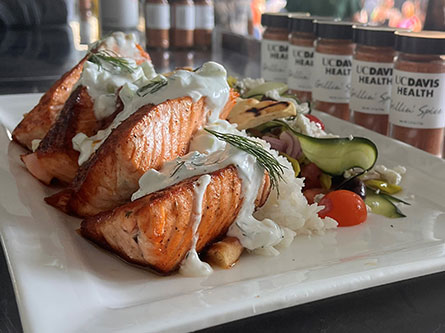The popular Paleolithic diet, or paleo diet, centers on the idea that eating like our ancestors aligns with our genetics and promotes good health. It’s also known as the caveman, Stone Age, or steak and bacon diet. A paleo dieter’s food choices are limited to what could be hunted, fished, or gathered in prehistoric times such as meats, fish, and vegetables.
The theory is that the rise in chronic diseases in modern society stems from the agricultural revolution. It suggests that adding grains, legumes, and dairy to meals may lead to a host of chronic diseases and conditions — from obesity to allergies.
UC Davis Health registered dietitians answer some of your questions about the paleo diet.
Is the paleo diet healthy?
Long-term studies don’t offer much information on how the paleo diet affects health. However, the diet has the potential to be a healthy way of eating. The typical paleo diet focuses on naturally raised meat and fish, as well as vegetables and fruits. It promotes avoiding dairy products and grains.
This diet can put you at risk for deficiencies in calcium and vitamin D, which are critical to bone health. At the same time, you may consume saturated fat and protein far above recommended levels due to eating so much meat. This can cause an increased risk of kidney and heart disease and certain cancers.
Did cave people really eat mostly meat?
People living in the Paleolithic period, or “cave people,” ate whatever their surroundings offered them. When surrounded by fish or marine life, that’s what they ate. In tropical habitats, people ate a variety of plant and animal foods. Calling a diet that consists mostly of protein the “paleo diet” isn’t accurate. Also, people living in earlier times simply didn’t live to the age when chronic diseases typically emerge.
The paleo diet calls for limiting carbs and dairy. Isn’t that a good thing?
We need carbohydrates, especially complex carbohydrates. Whole grains, fruits and vegetables are important fuels for brain and muscle function. But most of us can and should eat fewer refined carbs like desserts, chips, and sugary drinks. All of these add unnecessary ingredients and calories without the benefit of fiber, protein, vitamins, and minerals. Highly processed foods are often fortified just to appear healthy on nutrition labels.
If dairy intake is significantly limited and not replaced with other calcium food sources, calcium supplements and vitamin D may be needed. Paleo diet advocates often say dairy promotes inflammation. However, some research shows the opposite: low-fat dairy intake decreases inflammatory markers in the blood.
What are some benefits of the paleo diet?
A paleo eating plan that is high in fiber, potassium and antioxidants while being low in simple carbohydrates, sodium and sugar can be a healthy eating plan. It emphasizes local, sustainable, organic, and non-GMO foods and grass-fed meat options. It discourages foods that are highly processed or have artificial ingredients and colorings.
A paleo eating plan rich in fruits and vegetables could help you achieve most nutrient requirements. It may kick-start weight loss and, at least in the short-term, improve blood sugar and lipid profiles.
What are health risks that come with the paleo diet?
For most people, it’s very difficult to stay committed to any diet that’s too restrictive of one or more food categories. For that reason, the paleo diet isn’t effective for continued weight loss.
In terms of overall health, the paleo diet is high in saturated fats due to the increased intake of protein from animal food sources. Over time, people following the diet could see increases in cholesterol, particularly the less healthy cholesterol. This could increase the risk of heart disease.
Not getting enough calcium increases the risk of osteoporosis, rickets, and bone fractures. Continued low carbohydrate intake may lead to an overuse of fat for energy, or ketosis. It’s recommended that you work with your physician or registered dietitian if you want to do the paleo diet, especially those with heart, kidney, liver, or pancreatic disease. You should also talk to a physician or dietitian if you’re interested in trying the very low-carb version of the paleo diet.
What do you tell people who ask about the paleo diet?
Use the paleo diet as the starting point for a healthy eating plan. Add beans, lentils, nuts, whole grains, and low-fat or nonfat dairy or other calcium sources such as dark leafy greens, tofu, and soy or almond milk. Carefully choose lean protein sources, focusing on quality over quantity.
Plate balance is the key. Some resources for finding that balance are available at ChooseMyPlate.gov, the DASH (dietary approaches to stop hypertension) eating plan, or by talking to a registered dietitian. Fad diets go in and out of style. Always check with a qualified nutrition professional before making any big changes to your eating plan.
This post was reviewed by Kevin Calvillo-Chou, UC Davis dietetic intern, and Melinda Gong, UC Davis Health registered dietitian. It was originally published by UC Davis Health registered dietitian Alex Nella.




